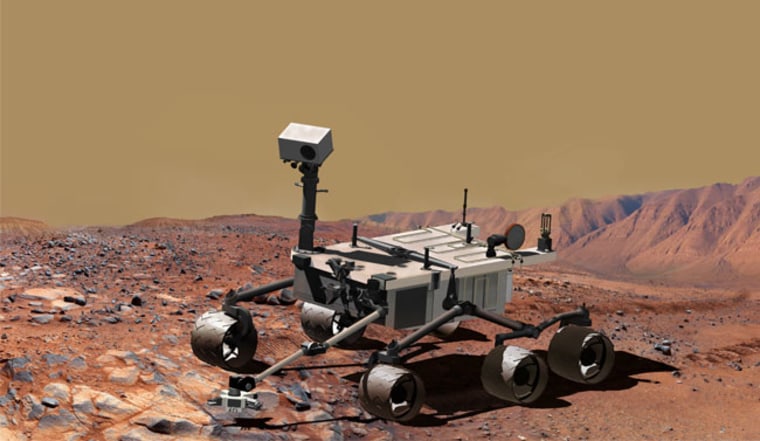The trouble-plagued, delayed, and cost-overrun Mars Science Laboratory mission is crawling out of the technical and financial dog house.
Still, there's one issue that could keep the roughly $2.3 billion NASA mission grounded: titanium parts that may not be strong enough for the robotic rover.
That's the word from NASA officials during a NASA Advisory Council's Planetary Science Subcommittee meeting held here earlier this month.
The good news comes from a November "Readiness to Proceed" review of the NASA Mars Science Laboratory (MSL) that took a hard look at problem-plagued actuators, the robot's avionics and power systems, as well as other aspects of the mega-rover.
The bottom line, according to Doug McCuistion, Director of the NASA Mars Exploration Program: Technical and budget activities are stabilizing and variables all appear to be converging.
The MSL rover has instruments designed to test the Martian surface for signs of past potential habitability. It has been beset by cost overruns and delays.
Right now, McCuistion reported, no insurmountable technical obstacles seem to be in the way of getting MSL Mars-bound in 2011. The nuclear-powered robot – now named "Curiosity" – is being built at the Jet Propulsion Laboratory (JPL) in Pasadena, California.
"MSL is really stabilizing both technically and budgetarily," McCuistion reported Dec. 3 to the subcommittee.
That being said, there is an MSL issue that needs resolution.
'Right stuff or wrong stuff'?
"One show-stopper...is still titanium," explained Jim Green, Director of NASA's Planetary Science Division.
The issue: It turns out that some 700 titanium parts used within the MSL have been identified so far. Still to be evaluated at the time of the meeting is use of the material in MSL instruments.
The problem: A firm that supplied titanium falsified documentation on the treatment of that material, saying it met military specifications. This translates to NASA concerns that the material may not be strong enough to hold up for Mars duty.
Slideshow 12 photos
Month in Space: January 2014
Now the task for NASA is finding out whether the titanium used in MSL is the "right stuff or the wrong stuff," McCuistion said. If it's on the edge, he said, then an assessment of risk to the MSL project will need to be weighed.
Diving into all the paperwork to understand the pedigree of the titanium is a labor-intensive activity. The necessary data should be compiled early next year. In a post-meeting communication with McCuistion, the MSL titanium parts identified to date has now risen to over 900, but nearly half of them have been cleared.
The biggest threat is use of suspect titanium in the large rover's rocker-bogie suspension system. That's the classy chassis of the machine, the base to which everything attaches.
That base needs to strong given the rover's touch-down via MSL's Sky Crane landing system.
If found to be a problem in that section of MSL, reproducing elements of that hardware to replace bad titanium "could stop us," McCuistion reported. "We're working this through...right now, we haven't run across anything that's a show-stopper," he added.
'Fingers and toes crossed'
"At this point, I know JPL engineers are working hard to complete construction and I have all fingers and toes crossed that MSL launches on time and lands successfully," said Fran Bagenal, Acting Chair of the NASA Advisory Council's Planetary Science Subcommittee. She's also a professor of astrophysical and planetary sciences here at the University of Colorado, Boulder.
How's MSL's escalating cost impacting non-MSL space activity?
"Obviously, a major lesson from MSL for all planetary missions is to work hard to improve the fidelity of budget estimates," Bagenal told SPACE.com. "We have put potential Outer Planet Flagship (OPF) missions through two cycles of science, technical, management and cost reviews. So, I believe the current estimates of the cost of the Jupiter Europa Orbiter mission," she said, "are at much better fidelity than MSL at the same stage."
Bagenal said she is concerned that the proposed future Mars missions in 2016 and 2018 have not been through such a review process.
"There is no non-Mars item that I could point to and say 'that was cut due to MSL,'" Bagenal said. "Certainly, elements of the Mars program have been hit hard."
Perhaps one way to look at the issue is to think about all the planetary science one might have done with MSL's $400 million-plus overrun to date, Bagenal observed. "That's a whole Discovery or Mars-Scout mission, or twice the annual total Research & Analysis budget," she concluded.

